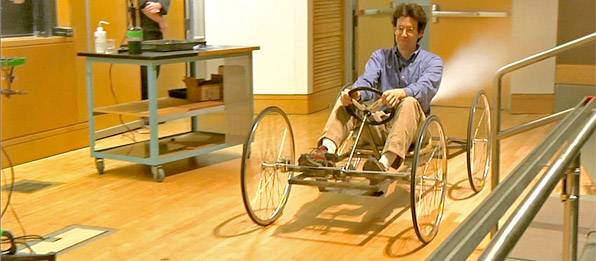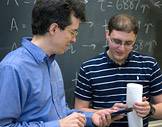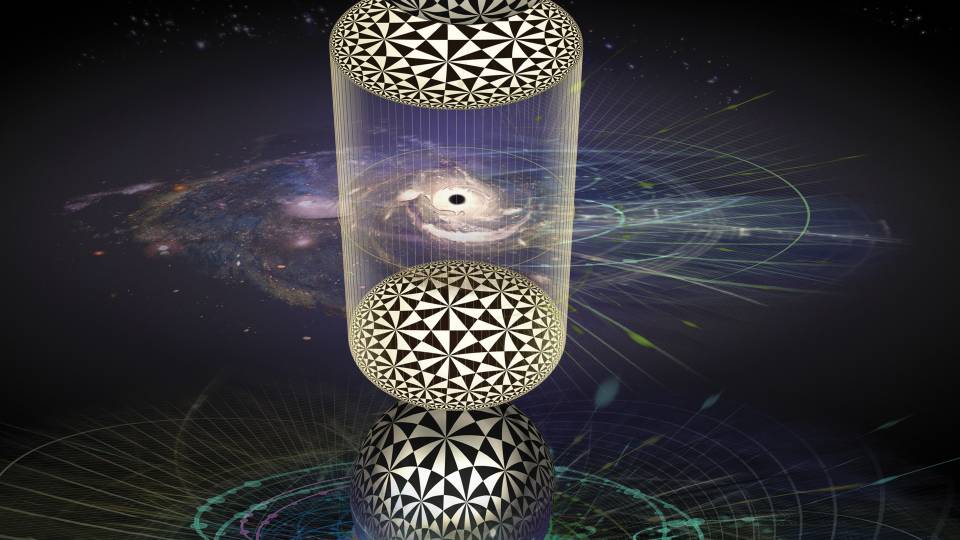Steven Gubser's cool, relaxed style and straightforward manner mask a fierce determination to make sense of the world and to bring along on his journey of discovery those who may not be privy to his knowledge.
A Princeton professor of physics, Gubser is one of the world's leading experts in string theory, a dazzlingly complex and still controversial branch of modern theoretical physics. The theory attempts to describe, in a mathematically consistent system, both matter -- the basic content of the universe -- and the known fundamental forces that act upon matter, such as gravity and electromagnetism.
There are frustrations and uncertainties inherent in the scientific endeavor, Gubser says, and in particular, his own field. But they are well worth it. He is committed to sharing the insights he gleans with students and the vast world of nonscientists.
"I want to be part of the effort by some scientists to convey their work to a broader audience," said Gubser, speaking one weekday morning in his sunny Jadwin Hall office.
An important part of this public-mindedness is Gubser's first popular science book, "The Little Book of String Theory," published in April by Princeton University Press. In a deft 162 pages, he describes some of his own ideas, but also strives to explain what many view as a maddeningly complicated branch of science that views fundamental particles like quarks and electrons as tiny, vibrating strings.
Often called "the theory of everything," string theory seeks to describe all the forces of nature in one unifying theory. The challenge: the theory is unproven. Though many of the world's leading physicists support it, some notable scientists do not.
The book acknowledges this scientific divide. "I don't want people to take it on faith that string theory is 'the theory of everything,'" Gubser said. "While it may be that, it is also an unfinished canvas. At the same time, it is an amazing technical and mathematical achievement."

In the classroom, Gubser's belief that physical concepts should be -- and can be -- clearly explained is evident to his students. He is known for taking abstract physical principles and applying them to everyday situations. Students also report that he clearly enjoys his subject and has fun teaching physics. (Photo: John Jameson)
Science as sleuthing
As exciting as the quest may be, it is not always obvious to researchers when they have sleuthed an important answer to one of nature's mysteries, Gubser said.
"With exploratory work," he explained, "everybody is feeling around in the dark. When you grab hold of something, you don't always know right away whether it is gold or steel."
It takes time to appreciate the depth of a scientific insight, he said. Gauging the importance of one's own research papers is equally difficult. "You put it out there and you think, 'That was really great,'" he said. "A few months go by, though, and you realize something. You say to yourself, 'You know what, that was kind of trivial.'"
But, he added, "You write another paper and you say, 'Ho hum.' Then you put it out there and it turns out that there is something really important there."
As a leader in this field, Gubser is well attuned to the ups and downs of scientific life: He already has written major papers and made key discoveries. He is one of the founders of the gauge-string duality, which equates string theory in five curved dimensions to another key set of concepts in physics known as four-dimensional field theories (those dimensions representing time and the three coordinates of space).
Quantum field theory, Gubser said, is the bread and butter of theoretical physics, covering ideas ranging from the structure of quarks inside a proton to the behavior of electrons in superconductors. Quantum field theory is hard to use, though, because it relies on daunting calculations. Scientists view the gauge-string duality as a major discovery partly because it provides simple geometrical tools for understanding such a complicated theory.
"It sounds like this could be a relation between one intractable subject and another," Gubser said. "But it's not that way at all. Lots of computations can be done on the string theory side using only geometrical ideas like black hole horizons, and these computations can then be related to interesting aspects of quantum field theories. In particular, one can compute properties of hot, dense, strongly interacting matter that are otherwise very difficult to probe theoretically."
In addition, the gauge-string duality provided a key connection to an area of science with an experimentally tested framework. Over the decades of string theory's development, it has been a significant source of concern that the subject was too far from experimental physics to remain relevant.
Part of what Gubser hopes to convey in his book is that "this subject called string theory is on the one hand speculative -- and that means it could be wrong -- but, on the other hand, it is the best hope we have for understanding the next level of subatomic particles." The object, he said, is to make a compelling case without overstating it.
Bringing enthusiasm to class
In the classroom, Gubser's belief that physical concepts should be -- and can be -- clearly explained is evident to his students.
"Professor Gubser has been one of my most memorable professors at Princeton," said George Maliha, a member of the class of 2013 who completed Gubser's Physics 102 course in May. "Over the months that he taught my physics class, he attempted to take abstract physical principles and apply them to everyday situations."
Sarah Urbut, a rising senior in molecular biology, praised Gubser for his attentiveness to student questions in the classroom. "He seems to have kind of a refreshing attitude about physics -- he clearly enjoys it and has fun teaching," she said.
Sometimes Gubser displays his enthusiasm in whimsical ways. Once, he chimed in on a discussion students were engaged in before class concerning the children's author Dr. Seuss, providing expert details on a character named Horton. "He went on to explain that he had just finished reading that story with his kids," said Carolyn Birbiglia, a rising senior majoring in anthropology. "In a way, he was more on our level after that and no longer just an elite physicist."
Gubser was not born to a life in physics. He found his way there. His father, Nicholas, a Rhodes Scholar and anthropologist, moved the family to Aspen, Colo., when Steven was a toddler. Nicholas Gubser left behind his academic work, which included a seminal study on the Nunamiut Eskimos, and turned to the mountains.
The younger Gubser, who dedicated his book to his father, grew up in a supportive intellectual atmosphere and enjoyed the outdoors, spending many hours hiking and skiing. He enjoyed school and was inspired by several teachers, most notably a seventh grade math teacher, Gary Kreutzer, who "made it all seem fun," Gubser said.
His love for physics also grew from reading books by the science and science fiction writer Isaac Asimov, especially one that explained black holes. Winning first place in the International Physics Olympiad, for which he traveled to Poland at age 17, clinched Gubser's career choice for him.
He became a student at Princeton University and excelled, earning his undergraduate degree in physics as the class of 1994 valedictorian. "What I mostly remember is that I was trying to do what worked and engage in projects that could lead to something," he said.

Gubser drives a go-kart fueled by carbon dioxide expelled from a fire extinguisher, tangibly illustrating the potency of stored energy, during Princeton's 2010 Science and Engineering Expo. (Image: Lisa Jackson)
Path to string theory
Gubser went on to earn his Ph.D. in physics from Princeton in 1998, working under Igor Klebanov, a professor of physics, as the two began a sequence of theoretical breakthroughs on the so-called gauge-string duality.
Now also the associate director of the Princeton Center for Theoretical Science, Klebanov remembers their first meeting. Gubser, then a Princeton junior, had approached Klebanov, asking if he could take his graduate level course on general relativity. "He seemed like a very smart and intense sort of guy," Klebanov said, noting that Gubser was already known as a star undergraduate. Gubser proved to be an outstanding student, earning an A-plus in Klebanov's course.
While still a junior, Gubser started working with Klebanov on what would be his senior thesis and the beginning of his life's work. Their first string theory paper together, "Scaling Functions for Baby Universes in Two-Dimensional Quantum Gravity," was published in Nuclear Physics B in October of Gubser's senior year. For his senior thesis amplifying that work, Gubser won the American Physical Society's 1994 Apker Award, which recognizes the top undergraduate physics thesis in the United States.
After postdoctoral work at Harvard University, Gubser joined the Princeton faculty in 2000.
Looking back, Gubser's entry in the field coincided with a period that is now regarded among physicists as the "second revolution" in string theory, following an earlier one in the mid-1980s. Joining ideas formulated by Juan Maldacena and Edward Witten of the Institute for Advanced Study in Princeton, Klebanov, Gubser and Princeton physicist Alexander Polyakov showed in a seminal 1998 paper that string theory is related in a simple way to quantum field theory. (As Gubser did, Klebanov, Maldacena and Witten also earned their physics doctorates from Princeton.) This led to a better understanding of particles known as hadrons, and suggested that string theory could yield insights that could be tested in the real world.
"We were both a bit lucky to stumble on this as a topic," said Klebanov. He and Gubser have written 19 papers together. "Our paper with Polyakov, and Witten's paper came out within a week of each other in February of 1998," Klebanov said. "By then, people were already studying Juan's paper. There was this incredible interest and concentration worldwide on this subject that is still continuing."
Experimentalist in everyday life
Gubser met Laura Landweber at Princeton in 2000 after emceeing a physics department music recital. He had sung Gershwin songs, accompanying himself on the piano. Now married with three girls, aged 1, 4 and 7, Gubser and Landweber, a professor of ecology and evolutionary biology at Princeton, share a passion for science and family.
Gubser the theorist shows his experimentalist side best, according to Landweber, when he is baking homemade breads with his daughters. All the girls participate in some stage of the process, with the littlest one punching down the dough.
Gubser has met with success as a scientist because he enjoys challenging problems and doesn't shy away from them, Landweber said. He also simply loves what he's doing, she added.
And while he may be bird-dogging the same theme throughout his career, his activities, she said, display different aspects of that interest.
"Theorists have a grand vision, but at other times they chase the latest experimental anomaly or theoretical idea," Landweber said. "Steve says that string theory's grand vision is that it incorporates, in principle, many or most of the central ideas in fundamental physics."
Gubser is always looking for ways to make string theory relate to more mainstream and experimentally accessible areas of physics. That could explain his most recent research focusing on how the behavior of black holes in string theory sheds light on the dynamics of the quark-gluon plasma, which is a recently discovered, high-temperature state of matter produced in collisions of heavy ions.
His comments, made when both he and Landweber received the Blavatnik Award for Young Scientists from the New York Academy of Sciences in 2008, explain how he interprets his odyssey. "I voyage in thought from colliding nuclei to black hole horizons, and people take me seriously," he said. "I think that's pretty exciting."





